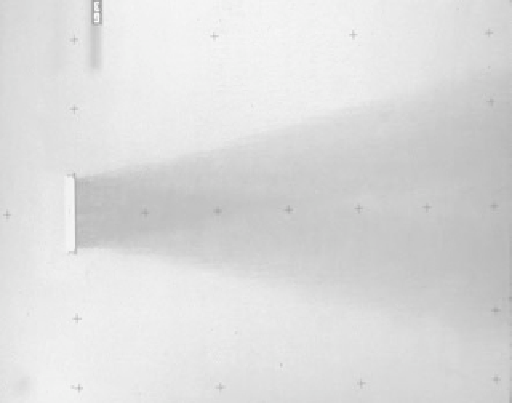Environmental Engineering Reference
In-Depth Information
seawater, but on the difference in densities and the
resultant buoyancy effect, which is parameterized by the
effective gravity,
g
′ (lT
−2
), defined by Equation (9.2).
The functional expression for the contaminant concen-
tration in the effluent plume at distance
y
above the
discharge port, Equation (9.24), can therefore be written
as
c
= ′
f c u B g u y
2
( ,
,
,
′
,
,
)
(9.25)
e
e
a
This relationship can be simplified by defining the
volume flux,
q
0
(l
2
T
−1
), specific momentum flux,
m
0
(l
3
T
−2
), and specific buoyancy flux,
b
0
(l
3
T
−3
), by the
relations
q
0
=
u B
(9.26)
e
Figure 9.9.
Plan view of a line plume.
Source
: Philip J.W.
Roberts.
2
m q u
=
=
u B
(9.27)
0
0
e
e
b
=
q g
′ =
u g B
′
(9.28)
0
0
e
port spacings necessary to prevent adjacent plumes
from merging, and plumes from individual ports typi-
cally merge together well below the rise height. In cases
where adjacent plumes merge together well below the
rise height, and the diffuser length is much greater than
the water depth, the effluent plumes behave very much
as if they were discharged from a slot rather than from
separate ports. A plan view of a (laboratory-scale) line
plume with an ambient current perpendicular to the
diffuser is shown in Figure 9.9. line plumes are charac-
teristic of deepwater outfalls, such as those typically
found off the west coast of the United States.
Consider the case of a buoyant jet that is discharged
through a slot of width
B
(l) at velocity
u
e
(lT
−1
); the
effluent has a density
ρ
e
(Ml
−3
) and contains a contami-
nant at concentration
c
e
(Ml
−3
). Consider further that
the ambient ocean has a density
ρ
a
(Ml
−3
) (assuming
unstratified conditions), a depth-averaged velocity
u
a
(lT
−1
), and we are interested in calculating the concen-
tration
c
(Ml
−3
) at a distance
y
(l) above the discharge
slot. The relationship between the contaminant concen-
tration,
c
, and the parameters controlling the dilution of
the effluent plume can be written in the functional form:
The variables
q
0
,
m
0
, and
b
0
involve only
u
e
,
B
, and
g
′,
and they can therefore be used instead of
u
e
,
B
, and
g
′
in Equation (9.25) to yield the following functional
expression for the contaminant concentration in the
effluent plume:
c
=
3
f c q m b u y
( ,
,
,
,
,
)
(9.29)
e
0
0
0
a
Using the Buckingham pi theorem, Equation (9.29) can
be expressed as a relationship between four dimension-
less groups, and the following groupings are particularly
convenient:
q c
u yc
= ′
l
l
l
l
y
l
0
e
M
M
f
,
,
(9.30)
4
a
Q
m
m
where
l
M
,
l
Q
, and
l
m
are length scales (l) defined by the
following relations:
q
m
2
0
l
Q
=
=
B
(9.31)
0
1 3
/
m
b
u B
g
4
0
2/3
e
l
=
=
(9.32)
c
=
1
( ,
f c u B
,
,
ρ ρ
,
,
g u y
,
,
)
(9.24)
M
2
′
e
e
e
a
a
m
u
u B
u
2
This functional relationship assumes that the port dis-
charge is fully turbulent and hence the viscosity of the
port discharge can be neglected. As in the case of a
single round plume, it can be assumed that the density
differences are small compared with the absolute densi-
ties (the Boussinesq assumption), and therefore the
kinematics of the plume does not depend explicitly on
the absolute densities of the effluent plume and ambient
0
2
e
l
=
=
(9.33)
m
2
a
a
The length scale
l
Q
measures the distance over which the
port geometry influences the motion of the plume, the
length scale
l
M
measures the distance to where the plume
buoyancy begins to become more important than the
discharge momentum in controlling the motion of the




Search WWH ::

Custom Search